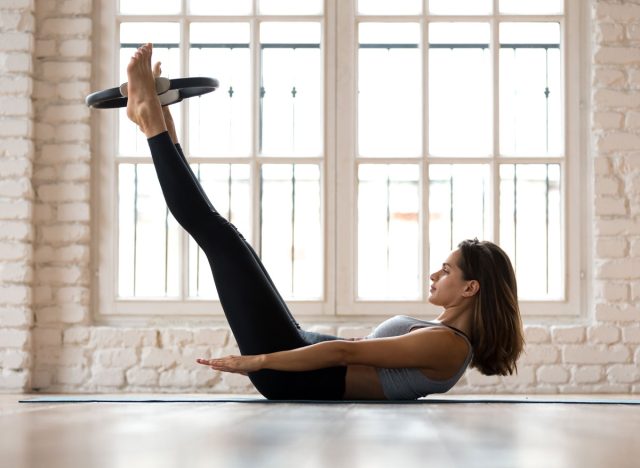10 Easiest Workouts To Lose Belly Fat

Kickstarting your journey to lose belly fat can feel daunting, but it doesn’t have to be. Trimming down stubborn fat in your midsection can become achievable and enjoyable with the right approach and selection of workouts. I’ve compiled a list of the 10 easiest workouts to lose belly fat and get into shape.
From low-impact exercises to high-energy dance routines, these workouts offer diverse options for various fitness levels and preferences. Whether you prefer the tranquility of yoga, the intensity of high-intensity interval training (HIIT), or the rhythm of Zumba, there’s something for everyone on this list.
So, let’s explore these effective and accessible workouts for belly fat, which will have you well on your way to achieving a slimmer waistline and improved overall fitness.
Calisthenics

You may already be incorporating calisthenic exercises into your weekly workout regimen. And if not, you’re probably familiar with them—they’re essentially bodyweight exercises. Think pushups, pull-ups, lunges, squats, planks, crunches, and glute bridges, among others.
The beauty of calisthenics lies in their versatility—they can be done virtually anywhere with minimal or no equipment. They’re easily adaptable to different fitness levels and offer ample room for creativity in your workouts, aiding in the journey to melting stubborn belly fat.
Yoga

Yoga offers a gentle yet practical approach to trimming belly fat. Its holistic practice engages the core muscles and the entire body, promoting strength, flexibility, and mindfulness. Poses like plank, boat, and bridge specifically target the abdominal muscles, aiding in toning and tightening the midsection.
Additionally, yoga’s focus on breath control and relaxation techniques can help reduce stress levels, which have been linked to abdominal fat accumulation.
Whether practiced in a studio or the comfort of your own home, yoga provides a versatile and accessible pathway to achieving your fitness goals, including a slimmer waistline.
Pilates

Pilates is a fantastic option for trimming belly fat with a low-impact yet highly effective workout. This method focuses on building core strength and stability, emphasizing controlled movements and proper alignment. Exercises like the hundred, the plank, and the roll-up target the abdominal muscles directly, promoting toning and sculpting of the midsection.
Pilates also encourages overall body awareness and alignment, helping to improve posture and reduce the risk of injury.
Whether practiced on a mat or using specialized equipment, Pilates offers a versatile and accessible approach to achieving a toned and trim waistline, all while enhancing strength and flexibility throughout the body.
Air Bike

The air bike, also known as the assault bike, offers a dynamic full-body workout, ideal for torching belly fat. With every pedal stroke, you activate muscles in your lower body—hamstrings, glutes, quadriceps, and calves—while simultaneously engaging your upper body by pushing and pulling the handles. This holistic engagement increases calorie expenditure, making it an efficient choice for those aiming for weight loss.
Keep your routine fresh with longer rides, varying intervals, or quick sprints with extended rest periods.
Running

Running is an accessible, versatile, and highly effective form of exercise. Its flexibility shines through in its adaptability to various terrains and environments. And when the weather isn’t ideal, a treadmill can provide a reliable alternative for your runs.
Whether you prefer long, steady-state runs to build endurance, moderate tempo intervals for a cardiovascular challenge, fast-paced sprints to boost speed, or hill sprints to enhance strength, running offers many options to suit your fitness goals.
Remember to kickstart your session with a thorough warm-up and ensure your shoes are securely tied. With consistency and dedication, you’ll be on your way to shedding that stubborn belly fat in no time!
Walking

Walking encompasses all the benefits of running but at a more leisurely pace. It’s accessible, adaptable, and highly effective as a form of exercise. Whether you walk indoors or outdoors, fitting in your workout is convenient and hassle-free.
In terms of versatility, the options are endless. You can enjoy leisurely strolls, incorporate intervals of brisk walking, or add intensity by incorporating dumbbells or wearing a weighted vest.
Starting a walking routine is as straightforward as putting one foot in front of the other, making it an excellent way to kickstart your calorie-burning journey and shed excess belly fat.
Cycling

Cycling offers a smooth and effective path to trimming belly fat while providing numerous benefits. Its accessibility is unparalleled, with options for indoor and outdoor rides, allowing for flexibility in your workout routine. Whether you prefer leisurely rides through scenic routes or high-intensity interval training sessions, cycling caters to various fitness levels and preferences.
Moreover, cycling is gentle on the joints, making it an ideal choice for individuals with joint concerns or those seeking a low-impact exercise option.
Beyond its accessibility and versatility, cycling is highly effective for revving up your metabolism, helping you burn calories both during and after your ride. This makes it a powerful tool for achieving your fitness goals, including a slimmer waistline.
Zumba

Zumba offers a fun and vibrant approach to shedding belly fat while enjoying a lively dance workout. Its accessibility makes it easy for anyone to join in, with classes available in gyms, community centers, and even online platforms.
Zumba’s versatility shines through its fusion of dance styles, such as salsa, merengue, and hip-hop. Participants can groove to their favorite beats while burning calories and sculpting their core.
Moreover, Zumba’s dynamic movements engage the entire body, including the abdominal muscles, helping to tone and tighten the midsection. With its infectious energy and lively atmosphere, Zumba makes exercising enjoyable and highly effective in achieving your fitness goals, including a leaner midsection.
Rowing

The rowing machine offers a dynamic and effective way to target belly fat while engaging multiple muscle groups. Its accessibility is unmatched, with rowing machines readily available in most gyms and easily usable at home.
The rowing machine’s versatility allows for various workout intensities, from steady-state rows to high-intensity interval training (HIIT) sessions, providing options for individuals of all fitness levels.
Rowing is a low-impact exercise that is gentle on the joints while delivering a powerful cardiovascular workout. Its full-body engagement, including the core muscles, helps sculpt and strengthen the abdominal region while boosting calorie burn and metabolism.
Incorporating the rowing machine into your fitness routine can be an enjoyable and effective way to achieve your goals, including reducing belly fat and improving overall fitness.
HIIT

HIIT workouts aren’t “easy,” per se, but they’re quick. If you’re in a pinch for time and don’t have hours to spend at the gym or need to work out from home, HIIT workouts are an easy way to get a lot of work done in a small amount of time.
Whether you choose equipment-based sessions or bodyweight circuits, HIIT workouts will get you one step closer to shredding that belly fat.





